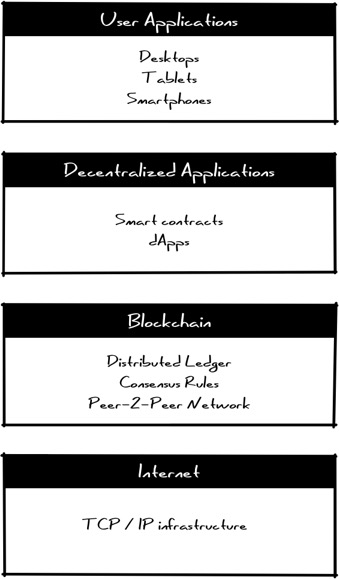Blockchain Architecture - Part 1: Introduction
04/01/18 22:23 Filed in: Blockchain
Part 2: Application Templates
Blockchain is a distributed and public ledger which maintains records of all transactions. A blockchain network is a truly peer-to-peer network and it does not require a trusted central authority intermediaries to authenticate or control the network infrastructure. With the blockchain’s ability to establish trust in a peer-to-peer network through a distributed consensus mechanism rather than relying on central authority. Blockchain has the potential to distrust not just the financial industry but also other industries including manufacturing, supply chain, logistics and healthcare.
There are two main parts in the Blockchain: the blockchain network, and the blockchain code. The blockchain network is the infrastructure where group of organizations to share data and processes together on a blockchain. The blockchain code runs on the blockchain network, and defines the organizations who can participate in the network. There are different categories of Blockchain including permissive (private), and public Blockchain models. A public blockchain network is completely open and anyone can join and participate in the network. The network typically has an incentivizing mechanism to encourage more participants to join the network. Bitcoin is one of the largest public blockchain networks in production today. A private blockchain network requires an invitation and must be validated by either the network starter or by a set of rules put in place by the network starter. Businesses who set up a private blockchain, will generally set up a permission network. This places restrictions on who is allowed to participate in the network, and only in certain transactions. Participants need to obtain an invitation or permission to join.
Blockchain operates on technology stack described below.

The blockchain protocol operates on top of internet stack through a peer-to-peer network of nodes. The stack is responsible for executing protocol, completing transactions based on a cryptographic consensus algorithm. The recorded transactions cannot be changed and can be inspected by anyone.
Decentralized applications (dApps) are applications that run on a P2P network of computers rather than a single computer. dApps are similar to a conventional web application. The front end uses the exact same technology to render the page. The one critical difference is that instead of an API connecting to a Database, you have a Smart Contract connecting to a blockchain. dApp enabled website: Front End → Smart Contract → Blockchain. As opposed to traditional, centralized applications, where the backend code is running on centralized servers, dApps have their backend code running on a decentralized P2P network. Customer interaction is done through user application layer. This is the consumer-facing part of the stack. These applications will work similar to current web or mobile applications but the main difference is they are built on decentralized protocols will be able to talk to each other.
Blockchain is a distributed and public ledger which maintains records of all transactions. A blockchain network is a truly peer-to-peer network and it does not require a trusted central authority intermediaries to authenticate or control the network infrastructure. With the blockchain’s ability to establish trust in a peer-to-peer network through a distributed consensus mechanism rather than relying on central authority. Blockchain has the potential to distrust not just the financial industry but also other industries including manufacturing, supply chain, logistics and healthcare.
There are two main parts in the Blockchain: the blockchain network, and the blockchain code. The blockchain network is the infrastructure where group of organizations to share data and processes together on a blockchain. The blockchain code runs on the blockchain network, and defines the organizations who can participate in the network. There are different categories of Blockchain including permissive (private), and public Blockchain models. A public blockchain network is completely open and anyone can join and participate in the network. The network typically has an incentivizing mechanism to encourage more participants to join the network. Bitcoin is one of the largest public blockchain networks in production today. A private blockchain network requires an invitation and must be validated by either the network starter or by a set of rules put in place by the network starter. Businesses who set up a private blockchain, will generally set up a permission network. This places restrictions on who is allowed to participate in the network, and only in certain transactions. Participants need to obtain an invitation or permission to join.
Blockchain operates on technology stack described below.

The blockchain protocol operates on top of internet stack through a peer-to-peer network of nodes. The stack is responsible for executing protocol, completing transactions based on a cryptographic consensus algorithm. The recorded transactions cannot be changed and can be inspected by anyone.
Decentralized applications (dApps) are applications that run on a P2P network of computers rather than a single computer. dApps are similar to a conventional web application. The front end uses the exact same technology to render the page. The one critical difference is that instead of an API connecting to a Database, you have a Smart Contract connecting to a blockchain. dApp enabled website: Front End → Smart Contract → Blockchain. As opposed to traditional, centralized applications, where the backend code is running on centralized servers, dApps have their backend code running on a decentralized P2P network. Customer interaction is done through user application layer. This is the consumer-facing part of the stack. These applications will work similar to current web or mobile applications but the main difference is they are built on decentralized protocols will be able to talk to each other.